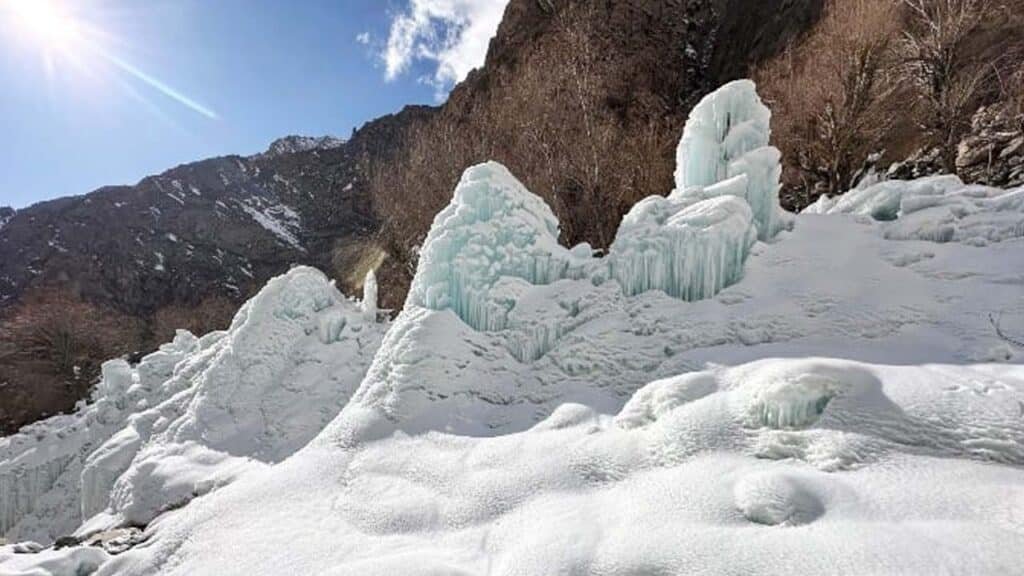Nestled beneath the towering, frost-covered peaks of Gilgit-Baltistan, a region known for its breathtaking landscapes and home to K2, the world’s second-highest mountain, a quiet yet remarkable transformation is taking place. Facing dwindling snowfall and shrinking water supplies, local farmers have come up with an innovative way to protect their livelihoods – by building ice towers.
These towering cones of ice, known as “ice stupas”, are manmade glaciers designed to store water during the winter months. As spring arrives and temperatures rise, the structures gradually melt, providing a steady flow of water to irrigate crops in the valley.
Farmers in Skardu, situated at around 2,600 metres above sea level in the heart of the Karakoram range, were growing increasingly anxious as winters became warmer and drier. “The snow wasn’t falling like it used to. We were worried about how to keep our orchards alive,” said Ghulam Haider Hashmi, a local farmer. In search of solutions, he and others turned to the internet.
That’s where they discovered videos by Sonam Wangchuk, an engineer and environmentalist from Ladakh, India, who pioneered the ice stupa concept nearly a decade ago. Inspired, the farmers decided to try it themselves.
Using basic equipment, they channel stream water through pipes and spray it into the air during sub-zero temperatures. As the water freezes mid-air, it gradually forms a cone-shaped tower of ice. “It has to freeze as it falls,” explained Professor Zakir Hussain Zakir from the University of Baltistan.
These ice structures, reminiscent of Buddhist stupas, act like natural reservoirs, slowly melting during spring and feeding the fields below just when water is needed most.
Gilgit-Baltistan is home to more glaciers than anywhere else outside the polar regions – over 13,000 in total. While the scenic glaciers and sparkling lakes have made it a magnet for tourists, they’re also a critical source of water. But according to researchers, the region relies more on seasonal snowmelt in spring than glacial melt during the summer.
“In the past, heavy snowfall was common between October and April,” said Sher Muhammad, a mountain hydrology expert at the International Centre for Integrated Mountain Development (ICIMOD). “But in recent years, it’s been unusually dry.”
The first ice stupas were built in the region in 2018. Since then, the practice has spread to more than 20 villages, benefiting over 16,000 residents, according to Rashid-ud-Din, head of the GLOF-2 project in Gilgit-Baltistan – a collaboration between Pakistan and the United Nations to tackle climate challenges.
Muhammad Raza, a farmer in Hussainabad, said his village built eight ice towers this past winter, storing about 20 million litres of water. “Now we don’t have to wait until June for the glaciers to melt,” he said. “The water from the stupas arrives earlier and keeps our crops alive.”
Ali Kazim, another farmer, recalled how planting once depended on the delayed melt of faraway glaciers. “Now, with the ice stupas, we can plant on time and save our fields.”
The benefits go beyond just timely irrigation. In Pari village, 26-year-old Bashir Ahmed said the extra water has allowed them to increase crop cycles. “Before, we used to sow only once a year. Now we can harvest two, even three times.”
Pakistan has been experiencing temperature rises at nearly double the global average, making it one of the most climate-vulnerable countries. With over 80 per cent of its land classified as arid or semi-arid, and much of its water supply coming from across borders, the country faces mounting challenges in managing its water resources.
While glaciers across the globe are retreating rapidly, the Karakoram range has shown some resilience. Still, experts warn of growing risks, from water scarcity to unexpected flooding.
But for many in Gilgit-Baltistan, hope lies in innovation. “Climate change affects everyone – rich or poor, cities or villages,” said 24-year-old Yasir Parvi. “We decided not to wait for help. These ice towers are our way of fighting back.”
Read next: New digital Hajj, Umrah guide launched in 16 languages
